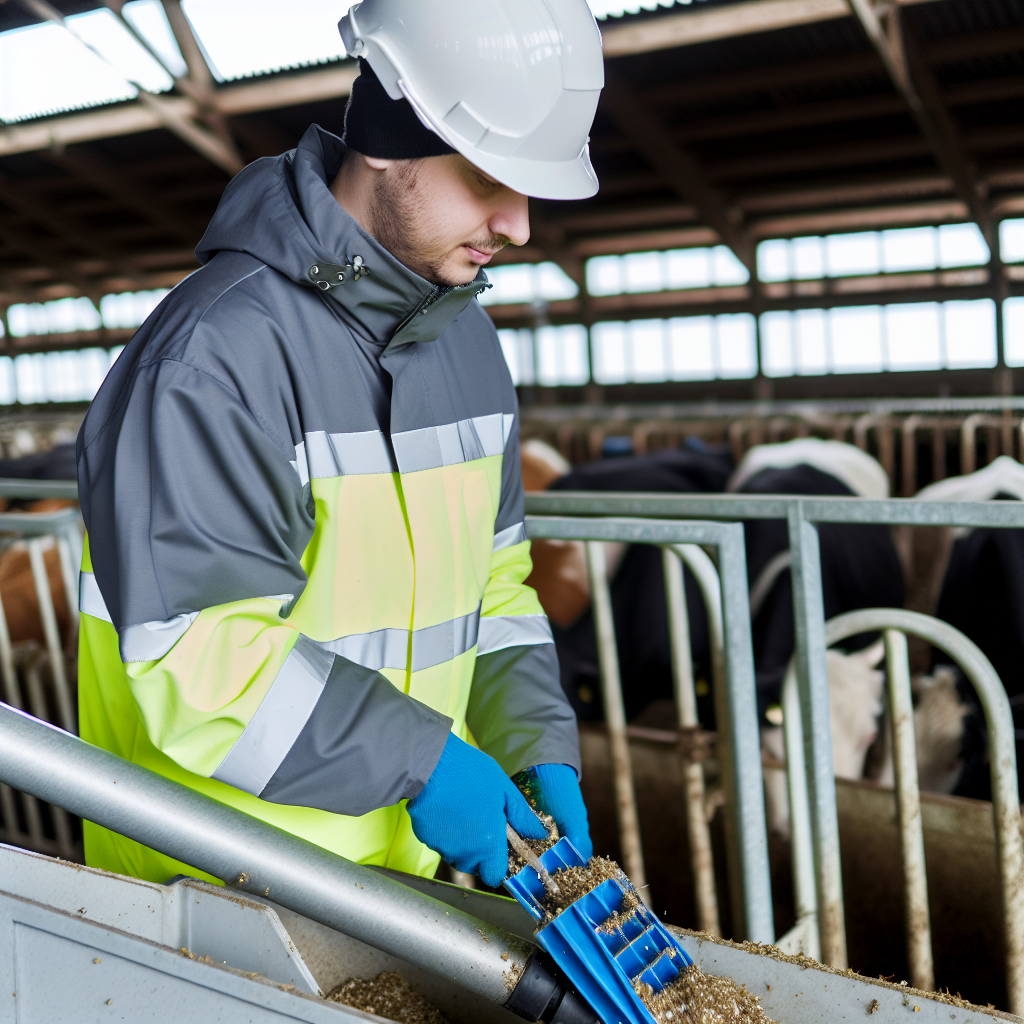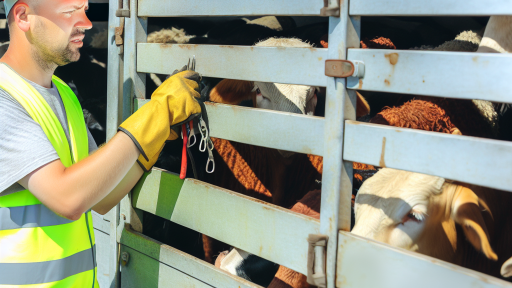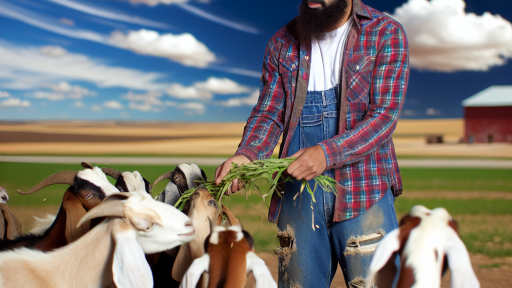Introduction to Waste Management in Livestock Facilities
Effective waste management is critical in livestock facilities.
This process minimizes environmental impacts and promotes sustainability.
Proper handling of waste enhances animal health and farm productivity.
Understanding different waste types is the first step.
Types of Waste in Livestock Facilities
Livestock operations generate a variety of waste materials.
Common types include manure, bedding, and feed waste.
Each type requires specific management practices.
For instance, manure can be processed into fertilizers.
Conversely, feed waste must be properly disposed of to prevent spoilage.
Importance of Waste Management
Effective waste management serves several purposes.
Firstly, it protects water quality by preventing runoff.
Secondly, it reduces odor and pest problems.
Additionally, proper waste handling can enhance farm profitability.
Finally, it meets regulatory requirements for environmental safety.
Strategies for Effective Waste Management
Farmers can implement various strategies to manage waste.
Transform Your Agribusiness
Unlock your farm's potential with expert advice tailored to your needs. Get actionable steps that drive real results.
Get StartedOne effective method is composting organic waste.
This process transforms waste into valuable soil amendments.
Another strategy includes utilizing anaerobic digestion.
This method generates renewable energy while treating waste.
Implementing a comprehensive waste management plan is crucial.
Challenges and Solutions
Waste management in livestock facilities faces unique challenges.
These challenges include regulatory compliance and operational costs.
That said, innovative solutions exist to address these issues.
For instance, technology can streamline waste processing activities.
Moreover, educational programs help farmers adopt best practices.
Types of Waste Generated in Livestock Operations
Manure Waste
Manure is the most significant waste produced in livestock facilities.
This waste includes feces and urine from animals.
It can vary in composition based on the species involved.
For example, poultry manure is rich in nitrogen.
Cattle manure tends to have higher organic matter content.
Feed Waste
Feed waste occurs when livestock do not consume all of their feed.
This waste can result from spoilage or improper feeding strategies.
Excess feed can attract pests and cause gastrointestinal issues in animals.
Reducing feed waste can enhance overall efficiency in livestock operations.
Wastewater
Wastewater originates from various cleaning and washing processes.
This can include water used for washing animal pens and equipment.
Runoff from feedlots can also contribute to wastewater issues.
Proper management of wastewater is crucial to prevent pollution.
Dead Animals
Mortality in livestock operations results in dead animals that must be managed.
Showcase Your Farming Business
Publish your professional farming services profile on our blog for a one-time fee of $200 and reach a dedicated audience of farmers and agribusiness owners.
Publish Your ProfileThese remain a significant challenge for many livestock producers.
Proper disposal methods are essential to prevent disease transmission.
Common methods include incineration and composting.
Other Byproducts
In addition to primary waste types, there are other byproducts.
These can include bedding materials, such as straw and sawdust.
These materials often require disposal or recycling.
Utilizing these byproducts can reduce overall waste volume.
Odor and Emissions
Livestock operations often produce odors that can affect neighboring areas.
Odor typically arises from manure and other waste products.
Moreover, gaseous emissions can impact air quality.
Effective management systems can mitigate these environmental concerns.
Impacts of Poor Waste Management on Environment and Health
Environmental Consequences
Poor waste management harms ecosystems and biodiversity.
It leads to soil degradation and nutrient depletion.
Additionally, it can contaminate water sources.
For example, manure runoff affects nearby streams and rivers.
This contamination can result in harmful algal blooms.
Such blooms diminish water quality and aquatic life.
Simplistically, inefficient waste handling results in odor issues.
These odors can impact local communities negatively.
Health Risks
Inadequate waste management poses serious health risks.
Pathogens in waste can spread diseases among livestock and humans.
Moreover, contaminated water can cause gastrointestinal diseases.
Farm workers are especially vulnerable to these health issues.
Consequently, communities face increased health care costs.
Vector-borne diseases can also surge in unsanitary conditions.
For instance, flies and rodents thrive in areas with poor waste control.
Long-term Implications
Over time, the impacts of poor waste management accumulate.
These impacts threaten food safety and public health.
Moreover, they can lead to stricter regulations for farms.
Ultimately, poor practices can undermine farm sustainability.
Farmers may incur higher costs when addressing these issues later.
Therefore, effective waste management is crucial for health and safety.
Gain More Insights: Sustainable Sheep Grazing Practices
Waste Management Regulations and Compliance for Livestock Farms
Understanding Waste Management Regulations
Waste management regulations govern how livestock farms handle waste.
These regulations aim to protect environmental and public health.
Each region often has specific laws regarding waste disposal.
Farmers must comply with both federal and state regulations.
Key Regulations Affecting Livestock Facilities
The Clean Water Act establishes guidelines for water pollution control.
It requires farms to obtain permits for discharges into water bodies.
The Resource Conservation and Recovery Act regulates hazardous waste management.
Showcase Your Farming Business
Publish your professional farming services profile on our blog for a one-time fee of $200 and reach a dedicated audience of farmers and agribusiness owners.
Publish Your ProfileAdditionally, local health departments enforce sanitation standards.
Farmers must also follow USDA guidelines promoting sustainable practices.
Record Keeping and Reporting
Accurate record keeping is essential for compliance.
Farmers must document waste generation and disposal methods.
Regular reporting helps ensure adherence to regulations.
This documentation serves as evidence during inspections.
Farmers can utilize software tools to streamline record keeping.
Best Practices for Compliance
Conduct regular training sessions for employees.
This training should cover waste management best practices.
Implement a waste reduction plan tailored to farm operations.
Regular audits can help identify areas for improvement.
Utilizing composting methods can reduce waste volume.
Collaboration with Environmental Agencies
Building relationships with local environmental agencies is beneficial.
These agencies can provide resources and guidance.
They may offer assistance in developing compliance strategies.
Farmers should participate in workshops and training offered by these agencies.
Staying informed about changing regulations is crucial for ongoing compliance.
Delve into the Subject: Preparing Your Farm for Livestock Transportation
Innovative Waste Disposal Methods in Livestock Facilities
Composting Techniques
Composting transforms organic waste into valuable soil amendments.
This method reduces landfill waste and improves soil quality.
Effective composting requires proper layering and aeration.
Regular monitoring of temperature and moisture is essential.
Additionally, it helps minimize odors and attract pests.
Waste-to-Energy Conversion
Waste-to-energy systems convert livestock waste into energy sources.
This process involves anaerobic digestion and biomass combustion.
These systems significantly reduce methane emissions.
Moreover, they provide renewable energy for farm operations.
Farmers can sell excess energy back to the grid.
Manure Management Plans
Developing a comprehensive manure management plan is crucial.
Such plans help to minimize environmental impacts.
They outline storage, treatment, and application methods.
Regular assessments ensure compliance with environmental regulations.
In turn, this promotes sustainability in livestock operations.
Integration of Technology
Modern technology enhances waste management efficiency.
Automated systems streamline waste collection and processing.
Additionally, data analytics improve waste treatment effectiveness.
Remote monitoring allows for timely adjustments to operations.
Consequently, this leads to reduced labor costs and improved sustainability.
Community-Based Solutions
Collaborating with local communities can improve waste management.
Farmers can share resources and best practices.
Showcase Your Farming Business
Publish your professional farming services profile on our blog for a one-time fee of $200 and reach a dedicated audience of farmers and agribusiness owners.
Publish Your ProfileCommunity composting initiatives provide additional benefits.
These programs foster local engagement and environmental awareness.
They support sustainable agricultural practices.
Gain More Insights: The Role of Genetics in Meat Quality Improvement

Technologies for Waste Treatment and Recycling in Agriculture
Introduction to Waste Management Technologies
Waste management technologies play a crucial role in livestock facilities.
They help reduce environmental impact and promote sustainability.
Incorporating these technologies can enhance farm productivity.
Composting
Composting transforms organic waste into nutrient-rich soil amendments.
This process utilizes microorganisms to decompose organic matter.
Farmers can enhance crop yields using composted materials.
Moreover, composting reduces landfill waste effectively.
Thus, it supports a circular economy in agriculture.
Anaerobic Digestion
Anaerobic digestion is a process that breaks down organic waste without oxygen.
This method produces biogas, which can be used for energy.
Farmers can utilize this biogas for heating or electricity generation.
Additionally, the digestate can serve as high-quality fertilizer.
This technology helps livestock facilities achieve energy independence.
Separation Technologies
Separation technologies focus on dividing solid and liquid waste streams.
These technologies make waste management more efficient.
Solid-liquid separators extract valuable nutrients from waste products.
Farmers can recycle these nutrients back into the soil.
Consequently, this process minimizes waste and enhances soil health.
Water Recycling Systems
Water recycling systems reduce freshwater consumption on farms.
They treat and recycle wastewater for agricultural use.
These systems help maintain a sustainable water supply.
Moreover, they mitigate pollution risks from farm runoff.
Innovative Fiber Products
Some technologies transform livestock waste into fiber products.
This offers an alternative resource for various industries.
Products may include biodegradable materials and packaging.
Such innovations contribute to waste reduction and resource recovery.
Implications of Waste Management Technologies
Implementing waste management technologies in livestock facilities drives sustainability.
These advancements not only improve efficiency but also protect the environment.
By embracing these methods, farmers set a positive example for future generations.
You Might Also Like: Goat Health Management Tips for Farmers
Best Practices for Sustainable Waste Management in Livestock Systems
Understanding Waste Management
Waste management in livestock facilities is crucial for sustainability.
Effective waste management minimizes environmental impact.
It also promotes animal health and overall productivity.
Waste Segregation and Minimization
Start by segregating waste at the source.
This involves separating organic from inorganic materials.
Additionally, minimize waste generation through efficient practices.
Showcase Your Farming Business
Publish your professional farming services profile on our blog for a one-time fee of $200 and reach a dedicated audience of farmers and agribusiness owners.
Publish Your ProfileIncorporation of Technology
Utilize technology to streamline waste segregation.
Automated systems can improve efficiency in waste sorting.
Monitoring systems can track waste output effectively.
Nutrient Recovery Techniques
Nutrient recovery is essential for closing the nutrient loop.
Composting organic waste enriches the soil.
This method recycles nutrients back into the farming system.
Using Anaerobic Digesters
Consider installing anaerobic digesters in your facility.
These systems convert waste into biogas and fertilizers.
Biogas can be used as a renewable energy source.
Implementing Best Practices
Adopt best practices for containment and storage.
Proper storage prevents nutrient runoff into waterways.
Ensure tanks and pits have appropriate lining and covers.
Regular Maintenance Checks
Conduct regular maintenance checks on waste management systems.
This ensures systems operate efficiently and effectively.
Address any leaks or damages promptly to minimize risks.
Regulatory Compliance and Community Engagement
Stay informed about local waste management regulations.
Compliance ensures sustainability and community trust.
Engage with the community to enhance collaborative efforts.
Educational Programs
Provide educational programs on sustainable practices.
These programs can benefit both employees and the community.
Knowledge sharing fosters a culture of sustainability.
Monitoring and Evaluation
Regularly monitor waste management practices for effectiveness.
Evaluate the impact of initiatives on sustainability goals.
Use data to adjust practices as needed for improvement.
Feedback Mechanisms
Establish feedback mechanisms for continuous improvement.
Encourage staff to report issues and suggest enhancements.
Act on feedback to promote a proactive waste management culture.
Case Studies: Successful Waste Management Practices in Livestock Farming
Implementation of Anaerobic Digesters
Anaerobic digesters have transformed waste management in livestock facilities.
These systems convert manure into biogas for energy use.
An exemplary case is the Green Acres Farm in Wisconsin.
They reduced methane emissions and generated clean energy.
Moreover, the farm utilizes digestate as a nutrient-rich fertilizer.
Composting Techniques
Composting offers another effective waste management method.
Smith Family Ranch in Texas exemplifies this approach.
They combine manure with carbon materials like straw.
This process enriches the soil and reduces odor.
Consequently, it improves overall farm sustainability.
Integrated Waste Management Systems
Integrated systems combine various waste treatment methods.
The Riverbend Livestock Company in Nebraska showcases this model.
They incorporate fermentation, composting, and nutrient recycling.
Showcase Your Farming Business
Publish your professional farming services profile on our blog for a one-time fee of $200 and reach a dedicated audience of farmers and agribusiness owners.
Publish Your ProfileAs a result, they minimize waste and enhance soil health.
Such systems also support animal health and productivity.
Best Practices in Waste Handling
Proper waste handling is essential for operational success.
The Larson Dairy in New York prioritizes regular waste removal.
They use mechanized systems to maintain cleanliness and efficiency.
Additionally, employee training ensures compliance with procedures.
This attention to detail significantly reduces environmental impacts.
Collaboration with Local Authorities
Partnerships with local authorities enhance waste management efforts.
The Sunny Fields Cooperative in California has successfully implemented this.
They collaborate on waste reduction initiatives and education programs.
This synergy fosters community support for sustainability practices.
Consequently, it improves the cooperative’s public image and outreach.




